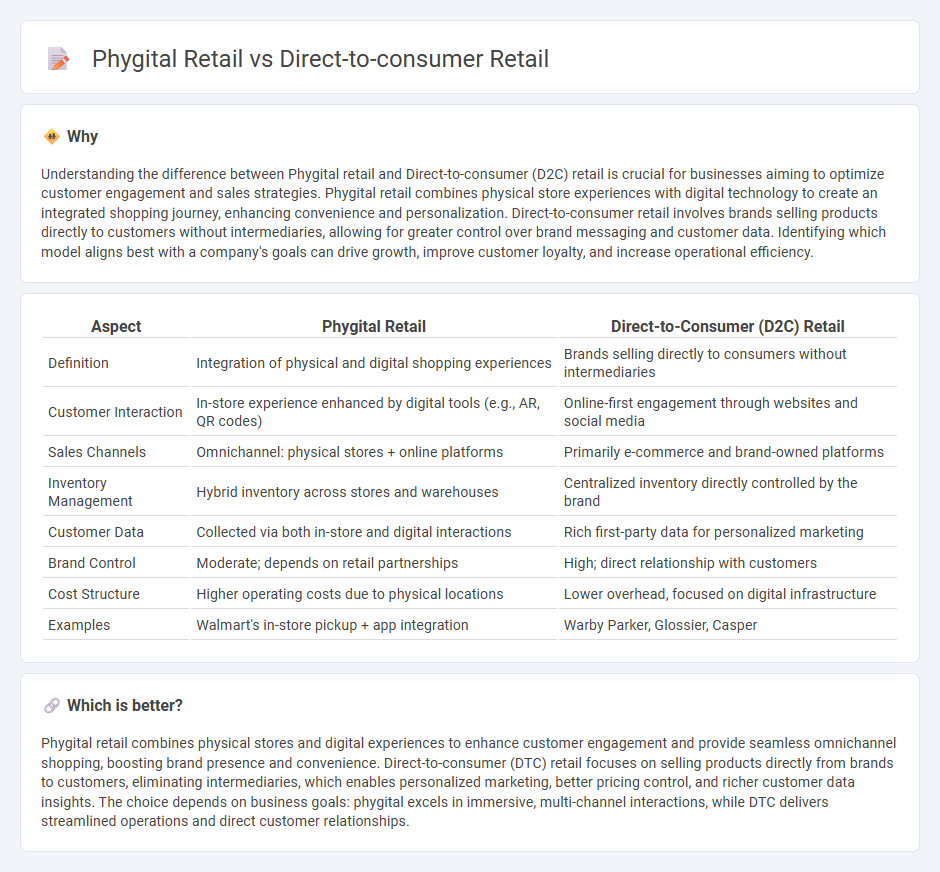
Phygital retail integrates physical stores with digital technology to create seamless, interactive shopping experiences, enhancing customer engagement and convenience. Direct-to-consumer (D2C) retail bypasses traditional intermediaries, allowing brands to build direct relationships with customers, gather valuable data, and offer personalized products. Discover how these innovative retail models are transforming consumer behavior and business strategies.
Why it is important
Understanding the difference between Phygital retail and Direct-to-consumer (D2C) retail is crucial for businesses aiming to optimize customer engagement and sales strategies. Phygital retail combines physical store experiences with digital technology to create an integrated shopping journey, enhancing convenience and personalization. Direct-to-consumer retail involves brands selling products directly to customers without intermediaries, allowing for greater control over brand messaging and customer data. Identifying which model aligns best with a company's goals can drive growth, improve customer loyalty, and increase operational efficiency.
Comparison Table
| Aspect | Phygital Retail | Direct-to-Consumer (D2C) Retail |
|---|---|---|
| Definition | Integration of physical and digital shopping experiences | Brands selling directly to consumers without intermediaries |
| Customer Interaction | In-store experience enhanced by digital tools (e.g., AR, QR codes) | Online-first engagement through websites and social media |
| Sales Channels | Omnichannel: physical stores + online platforms | Primarily e-commerce and brand-owned platforms |
| Inventory Management | Hybrid inventory across stores and warehouses | Centralized inventory directly controlled by the brand |
| Customer Data | Collected via both in-store and digital interactions | Rich first-party data for personalized marketing |
| Brand Control | Moderate; depends on retail partnerships | High; direct relationship with customers |
| Cost Structure | Higher operating costs due to physical locations | Lower overhead, focused on digital infrastructure |
| Examples | Walmart's in-store pickup + app integration | Warby Parker, Glossier, Casper |
Which is better?
Phygital retail combines physical stores and digital experiences to enhance customer engagement and provide seamless omnichannel shopping, boosting brand presence and convenience. Direct-to-consumer (DTC) retail focuses on selling products directly from brands to customers, eliminating intermediaries, which enables personalized marketing, better pricing control, and richer customer data insights. The choice depends on business goals: phygital excels in immersive, multi-channel interactions, while DTC delivers streamlined operations and direct customer relationships.
Connection
Phygital retail integrates physical and digital shopping experiences, enhancing customer engagement through seamless online and offline interactions. Direct-to-consumer (DTC) retail leverages digital channels to sell products directly to customers, enabling personalized marketing and data-driven insights. Together, phygital and DTC models optimize customer experience by combining the immediacy of in-store shopping with the convenience and targeting capabilities of digital platforms.
Key Terms
E-commerce Platform
Direct-to-consumer (DTC) retail emphasizes selling products directly through e-commerce platforms, eliminating intermediaries to enhance customer engagement and data-driven personalization. Phygital retail integrates online and offline experiences by combining e-commerce platforms with physical stores, enabling seamless omnichannel shopping and real-time inventory management. Explore the evolving dynamics between DTC and phygital retail to optimize your e-commerce strategy.
Omnichannel Experience
Direct-to-consumer retail emphasizes direct engagement with customers through online platforms, offering personalized shopping experiences and streamlined purchasing processes. Phygital retail integrates physical stores with digital technologies to create a seamless omnichannel experience that enhances customer interaction and satisfaction. Explore how blending digital innovation and physical presence transforms retail strategies and boosts consumer loyalty.
Brand-owned Channels
Direct-to-consumer retail leverages brand-owned channels such as proprietary websites and apps to foster direct engagement and data-driven personalization. Phygital retail combines physical stores with digital touchpoints to create immersive, seamless customer experiences while maintaining control through brand-owned platforms. Explore the strategic advantages of both models to optimize brand-owned channel performance and customer loyalty.
Source and External Links
Direct-to-consumer - Direct-to-consumer (DTC) or business-to-consumer (B2C) is a business model where brands sell products directly to customers, bypassing third-party retailers or wholesalers, primarily online but sometimes also via physical stores, with U.S. e-commerce sales surpassing $128 billion in 2021.
What Is Direct-to-Consumer? Everything You Need To Know - Direct-to-consumer retail means brands sell directly to customers--usually digitally--controlling fulfillment, marketing, and customer engagement to build relationships, gather feedback, and offer personalized experiences without middlemen.
A Beginner's Guide to Direct-to-Consumer Retail - DTC retail disrupts traditional retail by allowing manufacturers to sell straight to customers without retail distributors, leading to rapid e-commerce growth as more brands adopt this model to engage consumers directly.
 dowidth.com
dowidth.com